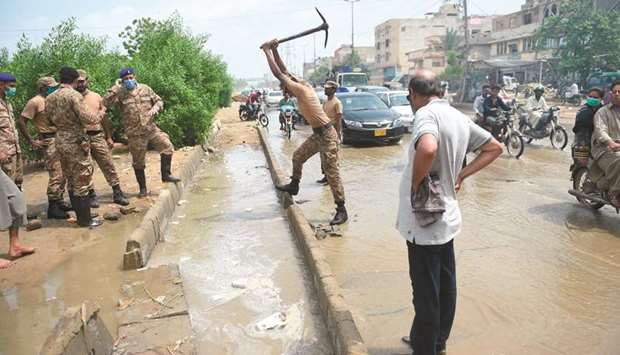The Pakistan Meteorological Department said yesterday that another spell of rain is expected in Karachi and parts of Sindh today and tomorrow, warning that there is danger of urban flooding yet again.
“Rain/wind thundershowers, with isolated heavy to very heavy falls, are expected in Karachi, Hyderabad, Thatta, Badin, Shaheed Benazirabad, Dadu, Tharparker, Nagarparker, Mirpurkhas, Islam Kot, Umar Kot, Sanghar, Sukkur and Larkana from Monday to Wednesday,” a weather advisory by the department said.
“Heavy rainfall may generate urban flooding/water logging in Karachi, Hyderabad, Thatta and Badin from Monday to Tuesday.
“Heavy downpour may generate flash flooding in hill torrents of Kalat, Khuzdar and Lasbela during the period,” it said.
The Met office also predicted rain-thundershowers with isolated heavy falls in Lasbela, Khuzdar, Awaran, Barkhan, Zhob, Musa Khel, Loralai, Kohlu and Sibi.
“Widespread rain/wind-thundershowers (with few heavy falls) are expected in Kashmir, Islamabad, Punjab, Khyber Pakhtunkhuwa and Gilgit-Baltistan from Tuesday to Thursday.
“Heavy rainfall may generate urban flooding in Peshawar, Charsadda, Mardan, Haripur, Rawalpindi, Gujranwala, Jhelum, Sialkot, Hafizabad, Sargodha, Lahore and Faisalabad on Wednesday and Thursday and may trigger landslides in the vulnerable areas of Kashmir, Gilgit-Baltistan (GB) and KP,” the department said, urging all authorities concerned to remain alert.
“There is a prediction of rain because of the system present in Sindh and Rajasthan and the humidity in the Arabian Gulf,” Met director Abdul Qayyum Bhutto said.
He forecast heavy winds and rain in Karachi for the next three days, adding that the metropolis, in particular, could experience thunder and heavy rains.
“There is a danger of urban flooding in Sindh and Karachi,” he said, adding that the province could see between 100-150mm of rain combined during this period.
Last week’s monsoon spell, the fifth one of the season, brought devastation to Karachi once again, claiming the lives of at least seven people and inundating roads in various parts of the city.
According to the Met department, the highest amount of rainfall, 185.7mm, was recorded in Surjani Town where people had to be evacuated after the rainwater flooded their homes.
The movement of traffic came to a grinding halt due to roads being submerged by rainwater while the power supply system showed no improvement as many areas were deprived of electricity till late in the night.
During the fourth spell earlier this month, at least nine people died in separate incidents in the city.
Seven of the deceased lost their lives due to electrocution, while two boys drowned while swimming in accumulated rainwater, according to officials and rescue services.
Karachi has a network of 550 storm drains which zig-zag through the metropolis and flow out into the Arabian Sea, but many are obstructed by illegal construction, waste and sludge.
The city’s infrastructure is struggling to cope with heavy monsoon rains, as seen this year.
Sardar Sarfaraz, Karachi head of the Pakistan Meteorological Department, said that rainfall of as little as 50mm (2”) could cause urban flooding in some of Karachi’s low-lying areas, with the most recent downpour easily exceeding that across the city.

An army soldier works to clear a blocked drain in a flooded area following heavy monsoon rains in Karachi.


